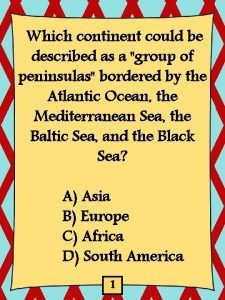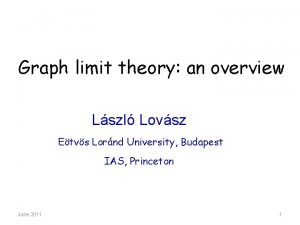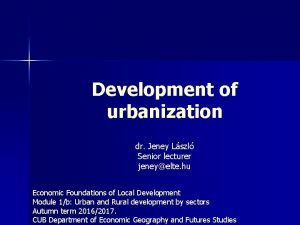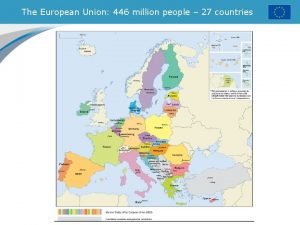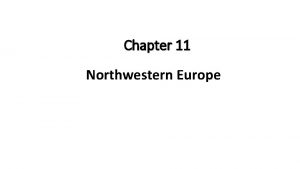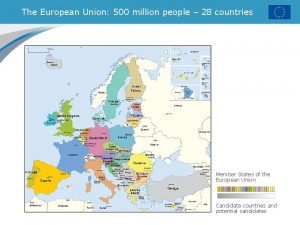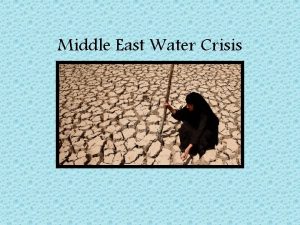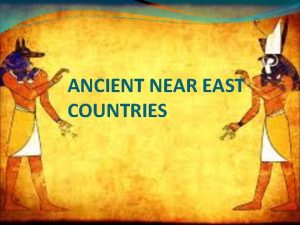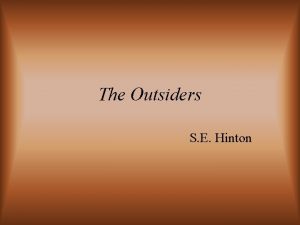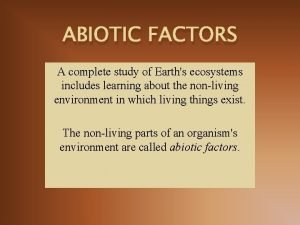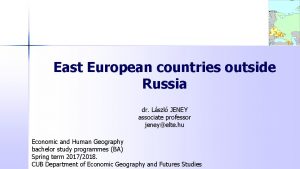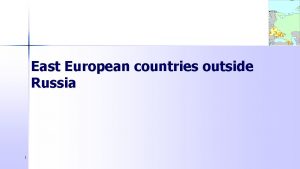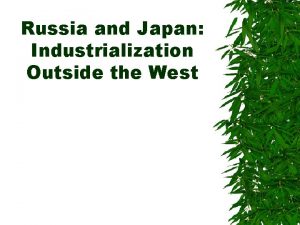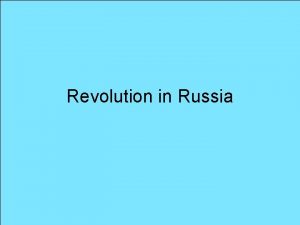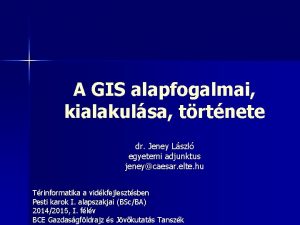East European countries outside Russia dr Jeney Lszl




















- Slides: 20

East European countries outside Russia dr. Jeney László Senior lecturer jeney@elte. hu Economic Geography I. International Business bachelor study programme (BA) Autumn term 2015/2016. CUB Department of Economic Geography and Futures Studies

State of economic development of Ukraine among the post. Soviet countries 2

Strong economic ties to Russia n n Ukraine, Belarus, Georgia and Armenia SU times: countries were tied closely together After transition: prefer greater independence Old connections hard to break – Eastern UA: most important iron and steelmaking region industries depend on: import oil and natural gas (mainly from Russia) 85% energy needs – BY: heavy industry 50% of trade with Russia n New connections difficult to form – SU: developed heavy industry equipment was not 3 kept up to date

Territory of today’s Ukraine in the 18 th– 19 th centuries 4

Territories annexed to Ukraine

Ukraine, the Bread. Basket of Russia n Chernozyom (black) soil, dry continental climate 6

Heavy industrial centre n Best quality – Black coal: Great Britain (Wales) and Donetsk Basin (East Ukraine) – Iron ore: Sweeden (Kiruna) and Krivoj Rog (East Ukraine) n Donetsk Basin (East Ukraine): the Craddle of Russian Heavy Industry (German settlers invited) 7

HOLODOMOR (genocide) 1931 – 1933 Ukraine (USSR) death toll ~ 7 million Ukrainian civilians


Main supplier of food n Till 1970’s: belonged to the growth poles of the SU – Main supplier of food and heavy industrial centre – Share in the SU: 18, 5% of population, 26% of coal production, 36% of iron industry – Heavy industry: 80% of industrial employment, 90% of investments, 70% of production n Conservation of bad economic structure after transition – Role of heavy industry, agriculture remained – Critical dependency of oil and natural gas supply (from Russia, Kazakhstan and Turkmenistan) – Soviet connections are hard to break, out-of-date firms are not competitive n Economic lagging – Per capita GDP, 1990: 4700$ (94% of the SU average of the former SU) mid-position in the rank – Living conditions (living area, salaries of employees, savings): also 10 under the post-Soviet average

Ukrainian Employment n Ukrainian employment – Manpower: 22. 3 mn n But: unemployment rate: 7 -8% – Rate of skilled workers: 50% n But: lack of management – Sectoral composition: n n n Employment: A: 25%, I: 20%, S: 55% GDP: A: 17% I: 43% S: 40% But: rising global prices for steel – 2005: important changes 11

Economic Geography of Ukraine n Regional development inequalities 2000 Regional differences – East: Russian minority, heavy industry more developed – West: Ukrainian majority, Hungarian, Polish, Romanian 12 minority

The vast majority of nationalities in today’s Ukraine 13

The vast majority of nationalities in today’s Ukraine Russian speaking population from 10 to 90 % 14

Mutual intelligibility and common vocabulary of Ukrainian language compared to: Belarusian: 84 % Polish 70 % Serbian: 68 % Croatian: 68 % Slovak: 66 % Russian: 62 %


Better state of Belorussian economy n n n Russian: main trading partner 1991: Russian – Belarusian Federation Cheap Russian oil and natural gas vulnerable 17

Southern Caucasus (Transcaucasus) n Georgia, Armenia – Mountainous (peaks above 5000 m) – Georgia: East Orthodoxy, Armenia: autocephaly Christianity n Azerbaijan – More flat (Caspian Sea coast: areas below sea level) – Muslim stronger linkages towards Asia n Historical states – BC 100: historic Armenia: also East part of contemporary Turkey (mount Ararat) – From the AD 1000 to 1200: Georgia – Turkish occupancy – Russian rulers till 1991 18

Economy of Southern Caucasus n In SU times (till 1991) – Georgia: 90% of SU’s tea and citrus fruits – Armenia: fruits (mainly grapes) n n n 2000 s: steadily improved Economies suffered greatly from the ethnic conflicts Increasing industrial and service sectors – Black Sea: SE part of ex-’Soviet Riviera’ (Batumi, Suchumi) n Developing trading relationship with US, EU and Iran – Georgia: reduction dependency on Russia 19

Ethnic conflicts in Caucasus Region n n Economic and cultural similarities: mountaineer identity Ethnically and linguistically one of the most complex area of the World: Christians and Muslims Russian control from mid 1800 s Soviets divided minorities – Karbardians (have more in common with Cherkessians), but grouped together with Balkars – Division of Ossethians – Armenians in Azerbaijan (Nagorno-Karabakh) War between 2 member states (Armenia and Azerbaijan) during the SU regime – Azeri Exclave: Nakhichevan 20
 The geographic feature most responsible for extensive trade
The geographic feature most responsible for extensive trade Graph limit theory
Graph limit theory Lszl charts
Lszl charts Dr jeney
Dr jeney Dr jeney
Dr jeney European union 28 countries
European union 28 countries How does climate change affect us
How does climate change affect us European union 28 countries
European union 28 countries Map of middle east countries
Map of middle east countries Gope
Gope Ancient near east countries physical education
Ancient near east countries physical education Physical activities of the primitive society
Physical activities of the primitive society Chapter 19 section 1 european explore the east
Chapter 19 section 1 european explore the east East is east and west is west
East is east and west is west Kalahari desert on africa map
Kalahari desert on africa map West north west wind direction
West north west wind direction They grew up on the outside of society
They grew up on the outside of society Quotations ap style
Quotations ap style Art without reference to anything outside itself
Art without reference to anything outside itself Non living things outside
Non living things outside Ellipse equations
Ellipse equations
